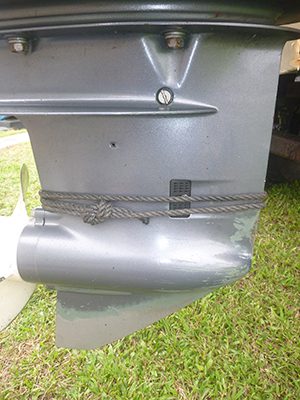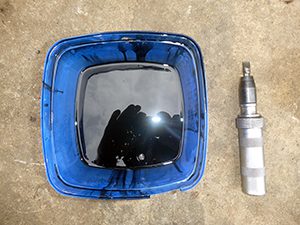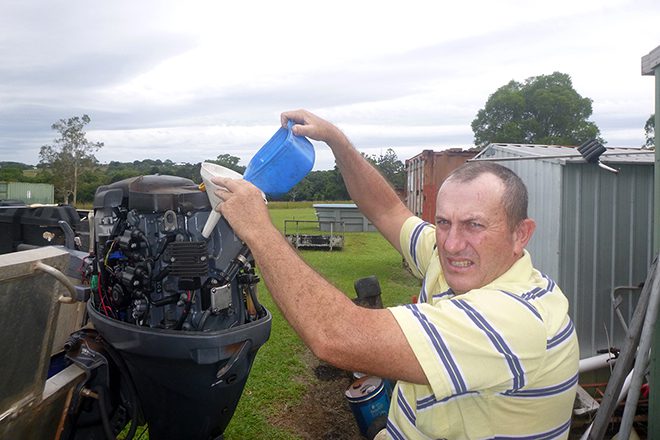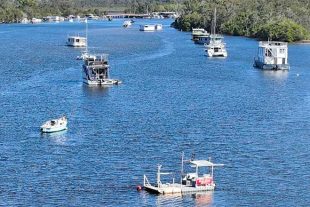

HI, Craig Tomkinson here. I hope everyone is coping well in these trying times and keeping active while isolating.
I thought I’d give our cars, four-wheel-drive, lawn mowers, gear and 60hp Yamaha outboard on my 5m tinnie a good and essential going over. Though only after recovering, because until the last 10 days of school holidays I was working – for 12 weeks. So when I did get time off, I came home and ate and slept for the first three to four days. It was great because I was stuffed from working and needed a good break.
I had a supply of oil as I’d previously bought 40 litres of Caltex Delo 400 MGX SAE 15W-40 – I’ve used Caltex oil in my motors for over 45 years. I bought the filters from Slips AutoMate Spares in Cooroy, and because they’ve supplied me for years, they give me a great price.
Now many people are daunted by the thought of servicing an outboard. Though it’s no different to your car or 4WD except the motor is horizontal – that’s it. In fact, if you flush your motor you should change the oil and filter every 50 to 100 hours, depending on how hard it works.
You shouldn’t have to tune it or bugger around with it. Because there doesn’t seem to be any difference in oil colour after 60 to 80 hours I generally rotate between a genuine and non-genuine oil filter, both do a great job. I tend to change my oil filter frequently as oil is cheap when compared to a rebuild. My preference is to put a 200-litre drum, with the top cut out, under my outboard leg and fill the drum with water.essential outboard
Start the motor and let it run until it warms up to around operating temp to give the motor a good flush and get the thermostat working. Check the prop in the drum is clear of everything, and at a slow idle put it in forward gear for a short time and then in reverse. This stirs the oil up in the gearbox, which will be changed later. Drain the water out of the drum, move it away and make sure the motor is level.
Next take the cowling off, undo the yellow fill plug in the top of the motor and take the drain bung out. Drop the oil out of the motor into a 4L container and have a rag there to wipe drips. You could set up a frame to hold the container so you can have a refreshing beverage while it drains. Once the oil has slowed to a drip, undo the old oil filter with an oil filter strap wrench and remove it.
Where the new filter seals, wipe the surface with a clean rag. On the new filter make sure to remove the thin plastic cover and wipe a smear of new oil on the O-ring seal on the top of the filter. Screw it back on and do it up firmly by hand, then wipe the motor bung clean and put it back in the motor. Tighten the screws but do not over-tighten otherwise you’ll strip the thread.
Four-stroke outboards are easy to overfill with oil, so ensure you read how much oil to put in yours. My motor takes 2.2 litres of oil, so I use a small funnel in the top oil fill plughole and slowly pour in a two-litre container of oil. Check the dipstick after each litre to confirm it’s at the right level, and when full put the top fill plug back in. Put the 200-litre drum back under the leg, fill the drum with water and start the motor. essential outboard
To make sure there are no leaks around the new oil filter, increase the RPM a little and after running it for a while, check the filter again. If no leaks are visible shut the motor off and let the oil settle before checking the level again with the dipstick. If the level is low, add a little more oil. Then drain the drum and put the cowl back on.
To change the leg oil, make sure the motor is level and prepare an impact driver with a big flat screwdriver head. With the impact driver set to turn left put in the flat-headed top screw on the gearbox and hit the back of it with a hammer a couple times until it becomes loose, then screw it out. Wipe clean and check the fibre washer has came out and is in good nick. Do the same to the bottom stainless-steel screw and let the oil drain.
You want to see clean oil come out. You do not want to see milky oil. If you do, it means the oil has water in it and you’ll want to check the seal behind the prop in case fishing line is in there. If the oil is a light milky colour, your stainless-steel screws may not have been tight enough or the fibre washers may need changing.
The leg oil in my motor was slightly dark so no water in it but it was due for a change. Once again while it drains, there is time for a beverage. Allow 15 to 20 minutes for the leg oil to drain. When it is a slow drip, ensure you have enough gearbox oil – mine holds about 700mls – to fill the leg from the bottom fill hole.
Pump or squeeze the oil in until it comes out from the top. When that happens replace the top stainless-steel screw, remove the oil filler and replace the bottom stainless screw as well. With the impact driver, do them up tight but do not strip the threads. My motor has done hundreds of hours now and the above is all I do.
It costs me about $60 for a service. I change the spark plugs and thermostat every 500-600 hours and the water pump impeller every 200-300 hours, though if you’re working a shallow bar like Noosa, change them about every 200 hours. My boat is used frequently for crabbing and fishing, so I do essential outboard maintenance regularly.
‘Til next month, stay happy in isolation.
 Bush ‘n Beach Fishing Magazine Location reports & tips for fishing, boating, camping, kayaking, 4WDing in Queensland and Northern NSW
Bush ‘n Beach Fishing Magazine Location reports & tips for fishing, boating, camping, kayaking, 4WDing in Queensland and Northern NSW









